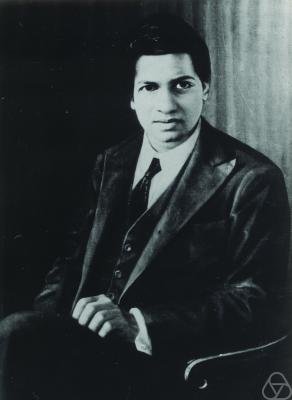
Srinivasa Ramanujan
‐
Prominent mathematician
Place of birth
Date of arrival to Britain
Location(s)
CB2 1TQ
United Kingdom
Place of death
Madras, India
Date of time spent in Britain
1914–19
About
Srinivasa Ramanujan is now recognized as one of the leading number theorists of the twentieth century, many of whose insights and breakthroughs weren’t fully understood until decades after his death. Although his time in England was one of great personal loneliness and poor health, his Cambridge years allowed him to build a collaboration with the British mathematician Godfrey Harold Hardy that was of fundamental importance for the work of both men. Hardy said later: ‘I learnt from him much more than he learned from me’. Hardy had invited him to come to England to share his thoughts and speculations on western mathematics, from his post as a clerk in the Madras Port Trust. There were connections through Hardy to Cambridge luminaries such as Bertrand Russell and the Apostles (most of the male members of Bloomsbury were Cambridge men, many of whom had been Apostles).
Ramanujan became the second Indian Fellow of the Royal Society in 1918, and the first Indian Fellow of Trinity College, Cambridge in the same year.
G. H. Hardy, Bertrand Russell.
Collected Papers of Ramanujan (posthumously published, 1926)
Hardy, G. H., Ramanujan: Twelve Lectures on Subjects Suggested by His Life and Work (Cambridge: Cambridge University Press, 1940)
Hardy, G. H., A Mathematician’s Apology (Cambridge: Cambridge University Press, 1940)
Kanigel, Robert, The Man Who Knew Infinity: A Life of the Genius Ramanujan (London: Scribners, 1991)
Kanigel, Robert, ‘Ramanujan, Srinivasa (1887–1920)’, Oxford Dictionary of National Biography (Oxford University Press, 2004) [http://www.oxforddnb.com/view/article/51582]
Leavitt, David, The Indian Clerk (London: Bloomsbury, 2007).
Ranganathan, S. K., Ramanujan: The Man and the Mathematician (London: Asia Publishing House, 1967)
Institute of Mathematical Sciences, Chennai
National Archives of India, New Delhi
Hardy papers, Trinity College, Cambridge
Image credit
Copyright: Mathematisches Forschungsinstitut Oberwolfach
